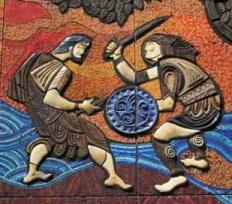Saint Kevin’s Cave – Hollywood
From time to time to get away from the crowds at Glendalough, Saint Kevin would walk twelve miles west over the hills via the Wicklow Gap to the village now known as Hollywood, where he stayed by himself in a cave called Kevin’s Bed (not to be confused with the cave in Glendalough also called Kevin’s Bed). Kevin probably discovered this cave when he went to that area to start a new church. That time, he was carried in a litter by servants. When they reached the village then called Cnoc Rua (Red Hill), from the colour of the summer vegetation on the hill south of the village, they found their way blocked by a wood, and they stopped.
“Why did you stop?” said Kevin.
“There are trees in the way,” they said.
“Don’t worry,” Kevin told them. “Just keep walking.”
They walked toward the wood, and the trees fell down in front of them to make a road. Kevin blessed the wood and promised “hell and a short life to any one who should burn either green wood or dry from this wood till doom”. That is how the village got its name, Holy Wood (“Sanctum Nemus” or “Sanctus Boscus” or “Seinbois” in medieval records), which by the 16th century became Hollywood. (A local man, Matthew Guirke, was responsible for naming Hollywood, California.) It is also called Cillín Chaoibhín in Irish, which means “Kevin’s Chapel”.
A hermit who lived in the cave in the 1960s told the children he was Saint Kevin, and they believed him. He left an inscription painted on the wall: “Help me Lord to find my true home.”
***
I’ve just found my source for the Glenmalure Man tale: The Wicklow People, 13/9/85. So you know it’s not a lie.
***
The well-known Wicklow story of Sam McAllister’s heroic sacrifice to allow rebel Michael Dwyer to escape a trap has a close parallel in a Cherokee tale.
“In the Cherokee war of 1760 when small bodies of the enemy, according to Haywood,* were pushing their inroads eastward almost to Salisbury, a party of six or eight warriors was discovered, watched, and followed until they were seen to enter a deserted cabin to pass the night. The alarm was given, and shortly before daylight the whites surrounded the house, posting themselves behind the fodder stack and some outbuildings so as to command both the door and the wide chimney top. They then began to throw fire upon the roof to drive out the Indians, when, as the blaze caught the dry shingles, and death either by fire or bullet seemed certain, one of the besieged warriors called to his companions that it was better that one should be a sacrifice than that all should die, and that if they would follow his directions he would save them, but die himself. He proposed to sally out alone to draw the fire of the besiegers, while his friends stood ready to make for the woods as soon as the guns of the whites were empty. They agreed, and the door was opened, when he suddenly rushed forth, dodging and running in a zigzag course, so that every gun was emptied at him before he fell dead, covered with wounds. While the whites were reloading, the other warriors ran out and succeeded in reaching the woods before the besiegers could recover from their surprise. The historian adds, ‘How greatly it is to be regretted that the name of this hero is not known to the writer, that it might be recorded with this specimen of Cherokee bravery and patriotism, firmness and presence of mind in the hour of danger.'”
* John Haywood, Natural and Aboriginal History of Tennessee, 1823
From Myths of the Cherokee by James Mooney, 1900



 English Like It Is: Right, Wrong and Changing Usage
English Like It Is: Right, Wrong and Changing Usage Richard Marsh, Bardic Storyteller
Richard Marsh, Bardic Storyteller The Key Bearer Saga, Book One: Earn Fire
The Key Bearer Saga, Book One: Earn Fire The Key Bearer Saga, Book Two: The Shore of Two Worlds
The Key Bearer Saga, Book Two: The Shore of Two Worlds